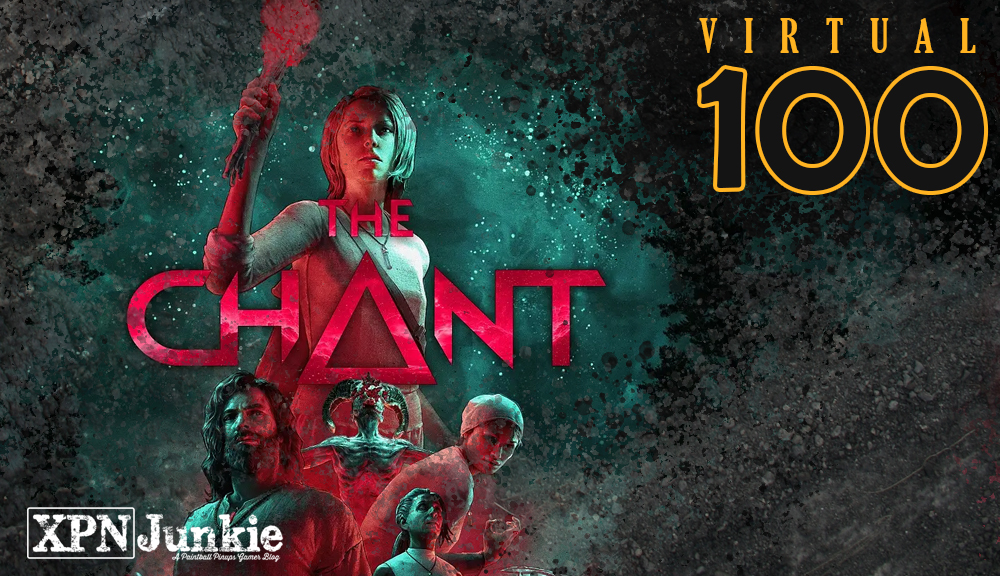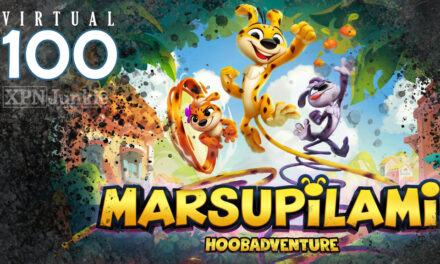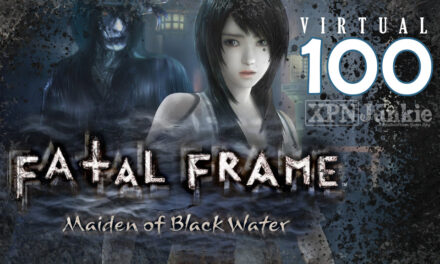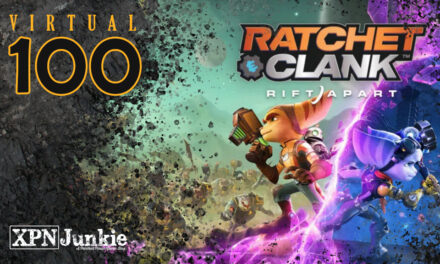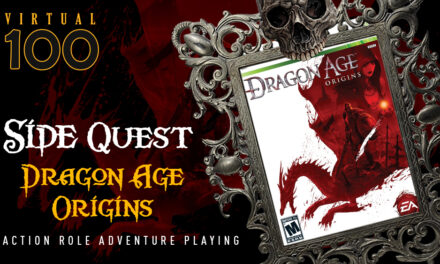The Virtual 100 – Game 5
I went on an interesting journey with The Chant. At first, I was diggin’ it. I liked the vibe. Then, it kinda went lukewarm on me. Then I hated it. Then it turned a corner, and I was like, “Ok, this isn’t so bad.” Then I started to really like it. Then, at the end, I kinda went sour on it again.
It took me a while to get to The Chant. Obviously, right? It’s on the backlog list. But even after I picked it up on a pretty steep sale, it took me a while to boot it up. The previews and trailers looked neat, but the game got lukewarm reviews, and nothing about it screamed “You need to play me right now.”
Which is fine, by the way. A lot of times I’ll grab a game if it’s ten or fifteen bucks with no intention of playing it right away. I have a feeling I’m not alone in this. But what happened with The Chant is that, well, I forgot about it. It wasn’t until quite a while later that I saw it in my library, downloaded it, and booted it up out of curiosity and sheer boredom.
And I played it, for a bit. Then, for reasons, I fell off of it and eventually forgot about it again. This story can be copied and pasted for most of the games in my backlog, it seems. Again, I don’t think I’m alone in this.
So for the Virtual 100, I came back around to it. I picked up from where I left off, and luckily, nothing here was too complicated or intricate to get back into. If anything it reminded me of why I fell off in the first place.
The combat sucks.
I’m not the person that complains about combat too often, unless there’s a mechanic that bugs me or something. But the combat here is just… bad.
I’m getting ahead of myself, though. Let’s rewind a bit.
For those of you who are uninitiated, The Chant is a survival horror game developed by Brass Token and published by Prime Matter. It focuses on an island retreat and the rehabilitation of a young woman named Jess that never really got over the death of her sister.
From the get-go, the place and the people seem creepy, as most spiritual hippies do. You know the kind. The ones that are just a little too “into it.” The ones that have to thank the bees for their honey, or keep yapping about their aura.
It turns out, the aura is an important factor on this island, because their cleansing consists of a chant that summons an alternate dimension full of creatures that feed on negative energy.
Creatures that feed on negative energy, on an island with people who all have emotional baggage? What could go wrong?
The thing is, the cult leader kind of knows about these creatures, and kind of knows about The Chant, because after he purchased the island he discovered the research of a scientist that was experimenting with the channeling and cataloging of said creatures. He knows enough to go through the motions, but not enough to actually… you know, not fuck everything up.
We all know people in our real lives that should never wield power tools. It’s kinda the same thing. It’s a “fuck around and find out” situation, and he fucks around, using the members of his cult as an experiment.
Well, surprise! The Chant goes awry, with one of the members flipping out and breaking the circle and running off before the chant can be completed. This allows the summoned creatures to run rampant on the island and make life miserable for everyone.
This all happens in the first hour of the game, so I’m not spoiling anything here. In fact, it’s an hour of exposition that probably could have been covered in the first twenty minutes. The Chant takes a while to get going, with all of this being very comparable to a walking sim, talking to everyone multiple times and reading found notes in the multiple cabins in the commune. It’s a slow burn that I suppose is a bit necessary to establish who everyone is and why they’re there.
It’s not a bad setup, to be honest. The main character discovers pretty quickly that all the Peace and Love hooplah is a facade, and most of the characters aren’t as happy or peaceful as they seem. There’s an underlying tension between the members, due to relationship drama and ulterior motives, the main character already feels as though she’s made a mistake going there. She was pretty much ready to get back on the boat and GTFO, and I didn’t blame her.
But, as things usually go in our lives, she ignores her gut instinct and goes along with it anyway, and that’s when the shit hits the fan and the game proper actually begins.
That’s when I realized just how clunky the combat is. Fighting off the creatures consists of mashing the attack button and then dodging when appropriate. It’s not the simplicity of the controls that’s the problem, it’s that the creatures are nimble and pack a punch, and our character is slow and clumsy. Her dodge mechanic is more of a “stumble.” Not figuratively, but literally. Tapping the dodge button will have her quick-step to the side or back, and if you tap the dodge button more than once quickly, she will stumble and fall. This is by design; she’s a normal human being and does not possess the fighting prowess required in such a situation. She’s set up to be a vulnerable protagonist, in more ways than one. But it makes dodging, which is your only mechanic to avoid damage, a bit clumsy. If you get the timing right, it can be effective and functional. The thing is, I actually got the hang of it after a while, and was able to handle most fights without too much trouble. But adapting to it was pretty slow for me, and it resulting in burning through a lot of resources early on.
One of the things I don’t like, that I’ve never liked, about the survival horror genre is the resource management. I hate resource management. I personally don’t feel like it ever really added anything to the genre. My favorite game series of all time is Resident Evil, and it has always been the aspect that I’ve liked the least. I enjoy the series far more when resources are plentiful and the challenge comes more from the enemies themselves rather than being punished for past choices and wasted ammunition. I get that the tension of the originals came in the lack of healing items and the capacity to carry them, but those old games were manageable, the enemies could be avoided if needed, and resources could be saved for later. The Chant isn’t quite as forgiving. Sometimes the enemies cannot be avoided, sometimes fights are necessary, and the resources needed for crafting the required weapons can be woefully rare. Different monsters require different weapons depending on whether their health is based on the mind, body or soul. These different health bars require the corresponding weapon to really do some damage.
Sometimes the resources for these weapons are few and far between, leaving the player with a weapon that’s not appropriate, which in turn doesn’t do as much damage, which results in using up that weapon, which robs you of that weapon for future battles. Each of the weapons require resources for crafting, and one of those resources is shared amongst them. So for example, if you have one Sage, and all three of the weapons require a sage, and the enemies coming at you are based on “body” then obviously you’re going to craft the weapon needed to do the most “body” damage. But now if you get attacked by a “mind” creature, and you don’t have the “mind” weapon, you’re kinda screwed. You have to use the “body” weapon you made and use it up.
I realize I’m making it sound a bit more convoluted in my explanation than it really is. But if I have to explain your combat system this way, is it really a good combat system? I think the game would’ve benefited from a simpler setup, but that’s just me.
The Chant is kind of a mish-mash between Lost and Stranger Things. The Gloom is very reminiscent of the Upside Down, and the research notes and film reels feel like they came straight from the Darma Initiative. And that’s actually kinda cool. But The Chant commits a cardinal sin, especially in the survival horror genre, and it’s that the setting never really changes. One staple of a survival horror game is that the further the character gets into the story, the more they get into the “thick of it.” In Resident Evil, it was the token laboratory. No matter if you were in a mansion, a city, a cabin in the woods, a port-a-potty, etc., there was always a secret laboratory underneath. In Silent Hill, it was when the transition to hell is permanent.
It’s the hobbits climbing Mt. Doom. It’s the Alien Queen’s nest. It’s the even horizon in… Event Horizon.
It’s the point in the story where the character can’t go any further, where they can’t get any more screwed. They’re there. It’s the end.
The Chant never really gets there. And I get it; the island is small, there aren’t much more than a smattering of cabins and a weird cult dome-church-thing. But at no point does it feel as though the stakes are raised. That the character is any more screwed than they were at the start. What exactly hangs in the balance? That much is never really made clear.
Before it was a cult camp, and before the research, it was a mining camp. And throughout the entirety of this game, the player is finding notes and letters and research papers talking about the mining camp and the workers finding the crystals and subsequently growing violent and such. But aside from a quick run-through of the mine in the middle of the game, there isn’t much to show for it. I was totally expecting the main character to have to delve into the depths of the mine to discover the source, and they just never went there.
The supporting cast is fodder, as they usually are, and each one has emotional baggage that they struggle with throughout the game. Well… until they succumb to their weaknesses. In true horror fashion they drop like flies.
As I said at the beginning, I went on a journey with this game. I really wanted to love it, but at the end I was a bit indifferent on the whole thing. After playing Callisto Protocol, where I set down the controller with a pretty good impression and the intention of one day playing it again, The Chant was just kind of a wistful sigh and an “Ok, well that’s done.”
The ending had a lot to do with that, and while I do feel like I’ve dropped some minor spoilers already, I’ll refrain from going into much detail. Let me just say that one of the last boss encounters of the game was pretty lame, and left way too many questions. During the entire story, nothing alluded to anything about the penultimate boss. None of the lore hinted at anything about it, but then suddenly, there it was. And I actually said aloud, “Really? They’re going there?”
The actual end boss was kinda cool, I’ll admit. I didn’t have a problem with that one. It left me with a decent feeling of accomplishment, as any proper end boss should. But then, that ending. That… awful, open-ended horror movie ending. You know the kind. “The protagonist survived and escaped…. OR DID SHE??” dun dun duuuuuun.
I fuckin’ hate those endings. Grow some balls and either end it or don’t. I can’t stand that ambiguous shit.
Callisto Protocol almost did the same thing, but that was more of a cliff-hanger to be continued type ending. That we’ll probably never see. But that’s a complaint for another time.
In all, as I said, I was left feeling a bit indifferent towards The Chant. It was okay. It wasn’t good enough to be memorable, and it wasn’t bad enough to be, well, memorable. But it’s done, and I’m moving on.
That’s another ten bucks in the piggy bank, and another game out of the backlog.

